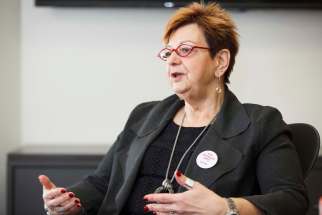Learning from Sweden’s failed experiment
Read this article for free:
or
Already have an account? Log in here »
To continue reading, please subscribe:
Monthly Digital Subscription
$19 $0 for the first 4 weeks*
- Enjoy unlimited reading on winnipegfreepress.com
- Read the E-Edition, our digital replica newspaper
- Access News Break, our award-winning app
- Play interactive puzzles
*No charge for 4 weeks then billed as $19 every four weeks (new subscribers and qualified returning subscribers only). Cancel anytime.
Read unlimited articles for free today:
or
Already have an account? Log in here »
Hey there, time traveller!
This article was published 02/06/2020 (1416 days ago), so information in it may no longer be current.
If anyone still doubts whether Canada made the right choice in shutting down schools, daycares and most businesses to contain the spread of the novel coronavirus, they need look no further than Sweden.
The Scandinavian country has one of the highest death rates from COVID-19 in the world, after keeping most of its schools and businesses open during the pandemic.
Sweden’s chief epidemiologist, Anders Tegnell, still supports the principle of avoiding a complete economic shutdown, but he now says the country could have done more to limit the spread of the disease.
“If we were to run into the same disease, knowing exactly what we know about it today, I think we would end up doing something in between what Sweden did and what the rest of the world has done,” Tegnell said in a recent interview.
As of Tuesday, Sweden had set a pace of 443 confirmed COVID-19 deaths per million people. It is lower than the mortality rate in hard-hit countries such as Spain and Italy and the United Kingdom, but it’s still eighth-highest in the world.
Meanwhile, Canada’s COVID-19 death rate per million people was at 195.
By keeping bars and restaurants open and allowing children to attend school, Sweden took a different approach than most countries. While social-distancing measures were recommended and large gatherings banned, life went on close to normal, even as the COVID-19 death toll mounted.
Tegnell hoped by sheltering the most vulnerable from the virus, including the elderly, most of the economy could remain open (an approach espoused by some critics in Canada and many factions in the United States).
It failed. It was a costly and dangerous experiment. About half of Sweden’s deaths thus far were elderly people living in long-term care facilities.
“We have to admit that when it comes to elderly care and the spread of infection, that has not worked,” Tegnell said. “Too many old people have died here.”
“If we were to run into the same disease, knowing exactly what we know about it today, I think we would end up doing something in between what Sweden did and what the rest of the world has done.” – Anders Tegnell, Sweden’s chief epidemiologist
Bjorn Olsen, professor of infectious medicine at Uppsala University, was more blunt, calling his country’s approach to the pandemic “one of Sweden’s biggest embarrassments and most tragic events.”
Most countries were not prepared to take such a gamble, even with the possibility a soft shutdown could help avoid economic ruin.
Sweden didn’t even benefit from that aspect. While its economic decline is expected to be slightly less severe than in neighbouring Norway and Finland (both of which implemented stricter lockdowns), Sweden is still projecting a seven per cent decline in GDP this year.
Some areas of Canada have been harder hit by the COVID-19 outbreak than others, including Montreal and Toronto, where mortality rates from the disease are higher than the national average. But had Canada taken the same approach as Sweden, its death toll would probably have doubled (or worse).
The success of the temporary shutdown is clearly evident in Manitoba. The province continues to see very low infection numbers, including a COVID-19 death rate of only 0.5 per 100,000 people.
Manitoba is an easier jurisdiction to manage than large, congested centres with incoming international flights, but actions taken by the province (and buy-in from the public) have also helped.
Dr. Brent Roussin, chief provincial public health officer, attributes the low numbers mostly to geography and timing (the virus arrived late in Manitoba). He doesn’t take much credit himself, but his office deserves praise.
The timing of when and what to shut down, including schools and daycares, and the focus on increased testing and contact tracing have been critical. When small outbreaks have occurred (such as a cluster in Brandon, or the handful linked to temporary foreign workers in the Southern Health region) testing and contact tracing have been swift and effective, stopping the virus in its tracks.
That’s good public health.
Locking down the economy for two months was extremely costly, but it was the right thing to do. The failed experiment in Sweden is strong evidence of that.
tom.brodbeck@freepress.mb.ca

Tom Brodbeck
Columnist
Tom has been covering Manitoba politics since the early 1990s and joined the Winnipeg Free Press news team in 2019.





